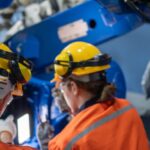An estimated 2 million people are diagnosed with lung cancer worldwide, and 1.8 million die from it.
Researchers at the University of Leeds have developed a new type of ‘magnetic vine robot’ that could potentially transform the diagnosis and treatment of cancer patients.
Engineers, scientists and clinicians from the University’s STORM Institute and Future Manufacturing Processes Research Group, in collaboration with the Morimoto Laboratory at the University of California, San Diego, IEEE Robotics and Automata Letters.
The vine-like robot with magnetic skin that grows using internal air pressure and steers using magnets is capable of growing on the move and fitting through gaps roughly 40% narrower than its resting diameter, allowing it to navigate narrow, complex pathways deep inside the human body.
Experts say that by magnetising the robot’s “skin” and controlling it with an external magnet, the tiny plastic robot can navigate an “S” curve, meaning it could potentially be used to treat tumours in the hardest to reach parts of the lungs, providing an advanced, minimally invasive surgical tool.
Currently, lung cancer is the leading cause of cancer incidence and mortality in the world, with lung cancers, including pulmonary nodules, non-small cell lung cancer, small cell lung cancer, and mesothelioma, responsible for an estimated 2 million diagnoses and 1.8 million deaths.
Professor Pietro Valdastri, Director of the STORM Lab and Research Supervisor at the University of Leeds, commented: “These new robots represent a major advancement in surgical navigation technology that has the potential to benefit millions of people.
“From diagnosis to biopsy to treatment, it has the potential to improve the safety and effectiveness of medical procedures, shorten recovery times and minimize surgical risks.”
Josh Davey, lead author of the study and a PhD student in the School of Electronic and Electrical Engineering at the University of Leeds, explained that the robot could reopen collapsed vessels inside the body, allowing surgeons to reach deeper into the body and ultimately transform the treatment of cancer.
“We’re making more cancers operable without causing too much trauma and damage, and paving the way for new ways of treating cancers that would otherwise require open surgery,” said Davie.








